May 22, 2020
Air Date: May 22, 2020
FULL SHOW
SEGMENTS
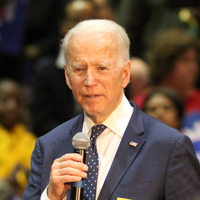
Democrats Launch Climate Change Task Force
View the page for this story
Former Democratic presidential rivals Joe Biden and Bernie Sanders have jointly chosen progressive and moderate members of a climate task force as part of a party unification effort. Moderate former Vice President Biden is the presumptive nominee and hopes to prevent acrimony with the more progressive supporters of Senator Sanders. Marianne Lavelle, a reporter from InsideClimate News, joins Bobby Bascomb for an overview of the climate task force and its potential impact on the Democratic Party platform. (09:47)

Beyond the Headlines
/ Peter DykstraView the page for this story
In this week’s trip beyond the headlines, Environmental Health News Editor Peter Dykstra and Host Bobby Bascomb discuss President Trump’s decision to invoke the Defense Production Act, requiring U.S. meat producers to stay open despite the public health risk. They also cover the severe drought in Bulawayo, Zimbabwe, limiting residents to only one day a week of water. And, they look back to the Lacey Act of 1900, the precursor to the Endangered Species Act. (04:49)
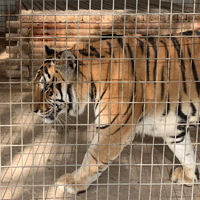
Backyard Tigers in America
View the page for this story
Private ownership of big cats is completely legal in several US states. In fact, experts estimate more tigers live in captivity in the United States than remain in the wild. Host Bobby Bascomb speaks with investigative journalist Rachel Nuwer, host of the podcast “Cat People”, about the exotic predators living in roadside zoos and backyards. (10:46)
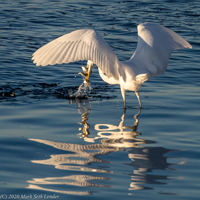
The Farmer The Grain The Miller The Sea
/ Mark Seth LenderView the page for this story
Living on Earth's Explorer in Residence, Mark Seth Lender, takes a moment to reflect on seeing the food chain of the Atlantic Ocean at work. (03:57)
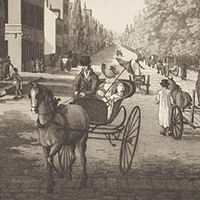
Animal City: The Domestication of America
/ Jenni DoeringView the page for this story
American cities were once home to large numbers of livestock: cows grazing Boston Common, pigs roaming through what’s now downtown Manhattan. Then the nineteenth century brought cultural change and reform, and a new relationship with animals. The history of this transformation is the focus of Animal City: The Domestication of America by environmental historian Andrew Robichaud, who spoke with Living on Earth’s Jenni Doering. (17:44)
Show Credits and Funders
Show Transcript
HOST: Bobby Bascomb
GUESTS: Marianne Lavelle, Rachel Nuwer, Andrew Robichaud
REPORTERS: Jenni Doering, Peter Dykstra, Mark Seth Lender
[THEME]
CURWOOD: From PRX – this is Living On Earth.
[THEME]
BASCOMB: I’m Bobby Bascomb.
In several US states it’s perfectly legal to own large wild predators including lions and tigers.
NUWER: We actually have no idea how many big cats are living here you know in backyards, truck stops, even in people’s basements. But a few years ago the Fish and Wildlife Service did estimate there are more tigers in the US than remain in the wild.
BASCOMB: Also, the history of livestock animals kept in American cities including dogs put to work pressing apples for cider and churning butter.
ROBICHAUD: Dogs are really widely used for labor in American life in the nineteenth century. So you have to sort of imagine a dog, on a treadmill, moving the treadmill, and that's moving an arm up and down to churn butter.
BASCOMB: The origins of the modern animal welfare movement. That and more this week on Living on Earth – Stick Around!
[NEWSBREAK MUSIC: Boards Of Canada “Zoetrope” from “In A Beautiful Place Out In The Country” (Warp Records 2000)]
[THEME]
Democrats Launch Climate Change Task Force

Joe Biden is the presumptive Democratic nominee for the 2020 Presidential election. (Photo: Carter Marks/Royals Media, NSPCA & ACP, Flickr, CC BY-NC 2.0)
BASCOMB: From PRX and the Jennifer and Ted Stanley Studios at the University of Massachusetts Boston, this is Living on Earth. I’m Bobby Bascomb. In for Steve Curwood.
Former Vice President and moderate Democrat Joe Biden emerged as the presumptive Democratic presidential nominee after left leaning Independent Senator Bernie Sanders suspended his campaign in early April. And now the two are working together to coalesce support for Mr. Biden in the fall election. Among other steps they’ve formed a unity task force on the climate crisis with members pulled from both the progressive and moderate wings of the Democratic party. For more I’m joined now by Marianne Lavelle. She is a reporter for Inside Climate News. Marianne, welcome back to Living on Earth!
LAVELLE: Glad to be here.
BASCOMB: So first of all, what is the stated goal of the climate change taskforce?
LAVELLE: Their goal is to write up recommendations for the Democratic National Committee platform. And for Joe Biden himself. He already has a very detailed climate plan. But, I think that the real goal of this task force goes beyond just the details of putting together a plan, but it is to show that Joe Biden is reaching out to every portion of the Democratic Party and wants to get everyone on the same side.
BASCOMB: And that seems to be demonstrated by the people that are on the task force. Can you give us a quick roll call. Who has been named to this taskforce by Vice President Biden and who was named by Senator Sanders?
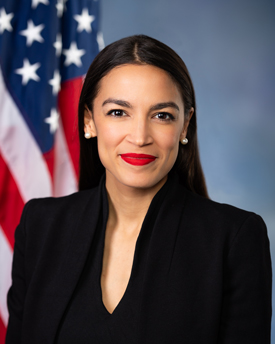
Alexandria Ocasio-Cortez (D-NY) is a Green New Deal advocate and one of the co-chairs of the Democratic climate task force, representing the more progressive wing of the Democratic party. (Photo: Franmarie Metzler, U.S. House Office of Photography, Wikimedia Commons, Public Domain)
LAVELLE: Right, so the co-chairs are Alexandria Ocasio-Cortez, the Representative from New York, who kind of rode into Congress based on her support of the Green New Deal. And the other co-chair is John Kerry, the former Secretary of State who really presided over the negotiations that led to the Paris Climate Accord. So, right there in the two co-chairs you have AOC, as she's called, is a protege of Bernie Sanders. And John Kerry represents the moderate core of the Democratic Party. So, there's a real effort there to bring the progressives together with the moderates.
BASCOMB: And how likely do you think it will be for them to unify the party on this issue of climate change?
LAVELLE: I would say that it is absolutely essential to do that. Not only for Biden to be victorious in November, but in the long run. Many of the analysts who have looked at this say it is really important for Biden to energize every portion of the Democratic Party. He cannot go into November with all the folks who are Bernie Sanders supporters sitting on the sidelines. There's just too great of a structural advantage for Donald Trump. Joe Biden can't go into that election without, for example, young people in Ann Arbor, Michigan, in State College, Pennsylvania. Those folks are in key states and they are key voters and they care about climate change, and they want to see bold action. They're really energized by the idea of a Green New Deal. So Joe Biden can't go into November just saying we're going to restore everything that Obama did, we're going to go back to four years ago, because that's really not going to be enough for those voters.
BASCOMB: Right. Senator Sanders' climate plan was quite a lot more ambitious than Vice President Biden's. How likely is it, do you think, that the nominees to the task force will be able to pull Biden's climate policy to the left a bit?
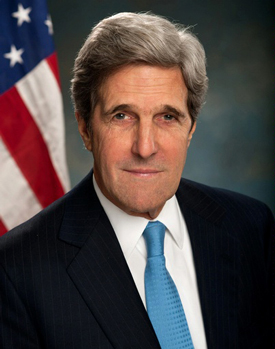
Former Secretary of State John Kerry, who was key architect of the Paris Climate Agreement, is one of the co-chairs of the climate task force, representing the more moderate wing of the Democratic party. (Photo: United States Department of State, Wikimedia Commons, Public Domain)
LAVELLE: I think that they will be able to do that because, in a way, the elements of Bernie Sanders' climate plan that Biden did not embrace were things like jobs and universal health care federally paid. Right now, we're in a situation where the economy, ravaged by the coronavirus, is going to demand a very strong federal helping hand on healthcare and on jobs. And I think that that is going to be a part of Joe Biden's platform, no matter what. I think the problem for Biden is going to be addressing things in places like western Pennsylvania, where fracking has been a large part of the economy. How does he maintain those moderate Democratic voters while embracing a bold climate policy? I will tell you that it is a very different situation now than it was even in the middle of the Democratic primary, and that is because the oil industry is really on its knees right now. And in a way, this works to the advantage of both Biden and those who oppose fracking, because they have the argument that this is a business that has always been volatile. And do we really want to build our economic future on the oil and natural gas business? Or do we want to build it on cleaner energy, where the jobs are going to be more stable and more predictable?
BASCOMB: Well, the Democratic National Convention is coming up in August. Who knows what that will look like this year with the coronavirus, but it's typically a time when the party meets together to sort of hash out the party platform on, you know, just about every issue. But how might this task force influence the party platform on the issue of climate change, do you think?
LAVELLE: Well, I think that the array of folks that Biden has brought into this task force will be bringing just a whole range of ideas that really will have to be part of any climate platform. For example, He brought Gina McCarthy, who was the EPA Administrator under Obama into the task force. She knows the ins and outs of regulation, the challenges that the EPA faces, and she's watched very closely as Trump has dismantled the EPA. It's going to be very important to have somebody who has a really detailed knowledge of those arcane sort of regulatory issues. It is going to be very important for making policy that there's a real deep understanding in a Biden administration of what is going to be necessary to rebuild the federal government's infrastructure. And then the other thing that Joe Biden has done is brought in experts on environmental justice issues who have looked at this issue from both, you know, rural Alabama and kind of the more urban centers and the environmental justice issues that those neighborhoods are facing. This is going to be important for energizing those in the African American community, and really making a convincing case that Joe Biden's climate policy is a climate justice policy, and that will be important for progressive and young voters as well.

Marianne Lavelle is a reporter for InsideClimate News. (Photo: Courtesy of Marianne Lavelle)
BASCOMB: And if you had to guess, what policies do you think might actually make it onto the Democratic party platform in August at the convention?
LAVELLE: Joe Biden has talked a lot about electrification of vehicles, and a pretty bold policy on EVs, and I think you're going to see something very bold on electric vehicles, because that really is an effort to say to voters in Michigan and Detroit, that we're going to re-energize the auto industry. And so I think that that's going to be a part of his policy. I also think restoring a look at community impacts when you are weighing things like new oil pipelines. I understand that Biden already has said he will take away the permit for the Keystone XL pipeline, maybe back to a ban on offshore drilling. I think those are really going to be important issues for important groups of voters and definitely for those who care about climate change.
BASCOMB: Marianne Lavelle is a reporter with Inside Climate News. Marianne, thank you so much for taking this time with me today.
LAVELLE: Thank you. Glad to be here.
Related links:
- InsideClimate News | “Biden Names Ocasio-Cortez, Kerry to Lead His Climate Task Force, Bridging Democrats’ Divide”
- InsideClimate News | “Joe Biden Must Convince Climate Voters He’s a True Believer”
- More about Marianne Lavelle
[MUSIC: David Bromberg, “It Takes a Lot to Laugh, It Takes a Train to Cry” on Try Me One More Time, by Bob Dylan, Appleseed Recordings]
Beyond the Headlines
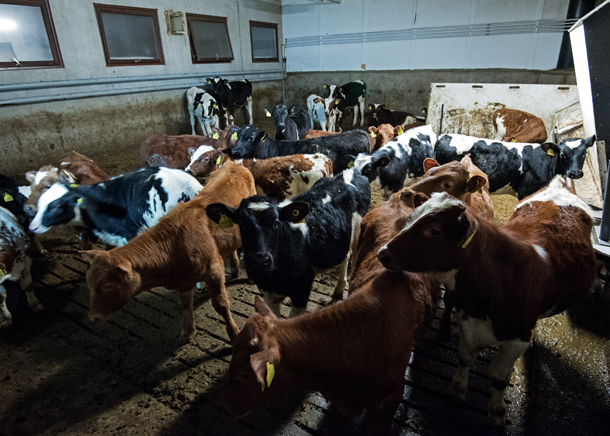
President Trump invoked the Defense Production Act, putting many U.S. meat packing workers at higher risk of Covid-19 infection. (Photo: Oikeutta eläimille, Flickr, CC BY 2.0)
BASCOMB: It's time for a trip now Beyond the Headlines with Peter Dykstra. Peter's an editor with Environmental Health News. That's ehn.org and dailyclimate.org. Hey there Peter, what do you have for us this week?
DYKSTRA: Hi, Bobby. Just about anybody knows who's been following the headlines - I won't use the old cliche of unless you've been living in a cave - although living in a cave sounds better and better. But, Coronavirus has been all over the headlines and they have a lot of major industrial victims, including United States meat packers. President Trump invoked the Defense Production Act in order to force U.S. pork and beef producers to stay open, despite the fact that so many of their workers are getting hard hit by COVID-19.
BASCOMB: Yeah, it's a real tragedy what's happening in that industry.
DYKSTRA: Yeah, but much of the pressure on the U.S. producers comes from the huge growing import and export business with China, one of President Trump's nemeses. The U.S. exported nearly one third of its pork production last year, and a third of those exports went straight to China, in part to help China recover from two years worth of African swine fever, which decimated China's domestic production. And now of course Chinese meat workers, just like their counterparts in the U.S., are dealing with Coronavirus.
BASCOMB: Right, and Smithfield, the largest pork producer in the world is actually owned by a Chinese company, yet their American workers are being required to work during this pandemic, putting their own health at risk to supply meat to China. I mean, doesn't really seem the intention of the Defense Production Act. You know, especially when many American grocery stores are running low on meat.
DYKSTRA: It's not, and there are many other applications of the Defense Production Act that the Administration has been criticized for being too slow, or not enacting at all. This one, particularly, since China has been posed as a nemesis by President Trump, just kind of sticks out as a little weird.
BASCOMB: Yeah, it really does. Well, what else do you have for us this week?
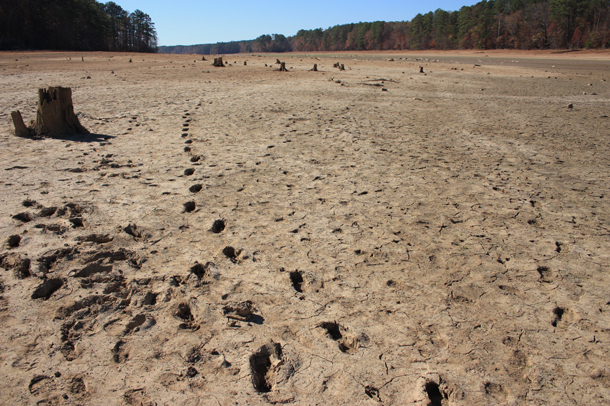
Severe drought continues in Southern African nations. Similar droughts have the potential to impact large U.S. cities in desert areas. (Photo: Alabama Extension, Flickr, CC BY 2.0)
DYKSTRA: We go to Bulawayo, which is the second largest city in the Southern African nation of Zimbabwe. They're in the grips of a non-Coronavirus crisis due to a severe drought that's lasted a few years throughout Southern Africa. Bulawayo's 600,000 people are now limited to one day a week of tap water.
BASCOMB: Wow. Yeah, that's got to make it really hard to keep your hands clean and you know, stay safe from the virus. And of course, about two years ago, Cape Town in South Africa was in a very similar situation of nearly running dry.
DYKSTRA: Yeah, they were literally on the verge of running out of their water supply. Things have gotten slightly, maybe temporarily better there. But, it's a huge problem throughout the nations of Southern Africa. And it may be a huge problem in other areas, even in the U.S. in cities like Las Vegas and Los Angeles that are essentially in the desert atmosphere with more and more demand for water from growing populations.
BASCOMB: Well, what do you have for us from the history books this week?
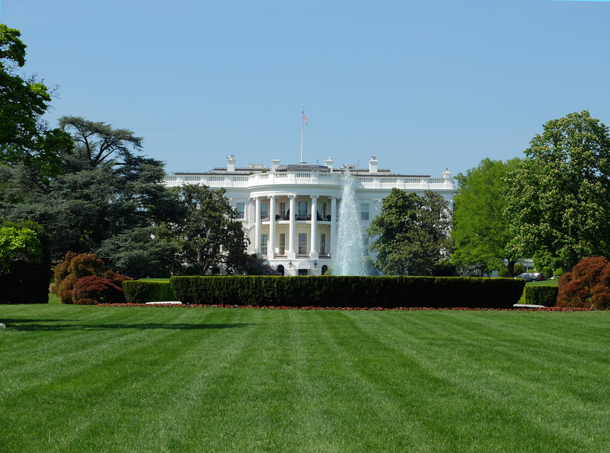
On May 25, 1900, President William McKinley signed the Lacey Act, which has saved many species from extinction. (Photo: Mathieu Thouvenin, Flickr, CC BY 2.0)
DYKSTRA: The year 1900, we used to call it the turn of the century, now we need to call it the turn of the last century, here in 2020. But on May 25, 1900, President William McKinley signed the Lacey Act. It's the precursor to the Endangered Species Act.
BASCOMB: And what was the catalyst for that?
DYKSTRA: Well, one of the catalysts for it was the trade in plumage from colorful birds. Back in the day, plumage was valued for women's hats, and it caused a widespread slaughter for a lot of the prettiest bird species we have out there. The Lacey Act may have been the central fact that saved wild species, like flamingos and many other birds that were being wiped out for fashion. Congressman John F. Lacey - he was a Republican Congressman who predated Teddy Roosevelt as a Washington based conservationist.
BASCOMB: And was he pretty successful with the Lacey Act, do you think?
DYKSTRA: The Lacey Act is still in effect, it's been strengthened. Those beautifully plumaged birds are no longer dropping like flies. Much of that is due to Congressman John Lacey of Iowa, and the Lacey Act.
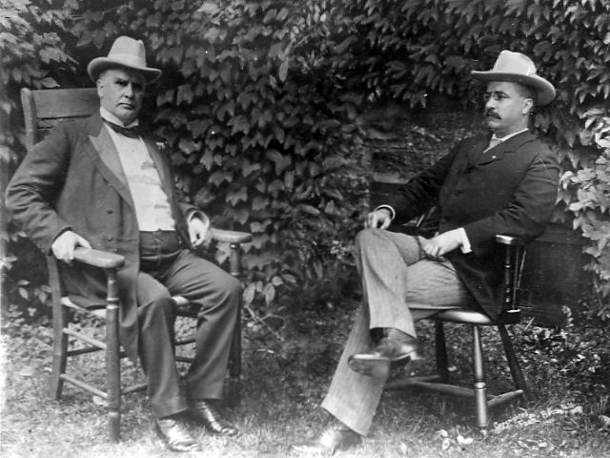
William McKinley, left and Theodore Roosevelt, right. Some believe this is a composite photo hastily made for campaign literature, as Mr. Roosevelt was selected at the last minute during the Republican National Convention in 1900 as President McKinley’s running mate for the latter’s second term, following the death of Vice President Garret Hobart. (Photo: DCPL Commons, Flickr, CC BY 2.0)
BASCOMB: Well, our hats off to him, then.
DYKSTRA: Make sure those hats don't have any plumage in them.
BASCOMB: Oh never, never. Alright, well thanks, Peter. Peter Dykstra is an editor with Environmental Health News. That's ehn.org and dailyclimate.org. We'll talk to you again really soon.
DYKSTRA: Okay, Bobby, thanks a lot. Talk to you soon.
BASCOMB: And there's more on these stories at the Living on Earth website, loe.org.
Related links:
- Reuters | “As U.S. Meat Workers Fall Short and Supplies Dwindle, Exports to China Soar”
- World Economic Forum | “Cape Town Almost Ran Out of Water. Here’s how it Averted the Crisis”
- Al-Jazeera | “Drought Adds to Hardships as Zimbabwe Economy Hits”
- Learn more about the Lacey Act
[MUSIC: David Bromberg, “It Takes a Lot to Laugh, It Takes a Train to Cry” on Try Me One More Time, by Bob Dylan, Appleseed Recordings]
BASCOMB: Coming up – The legality and animal welfare concerns of owning top predators in the United States. That’s just ahead on Living on Earth.
ANNOUNCER: Support for Living on Earth comes from Sailors for the Sea and Oceana. Helping boaters race clean, sail green and protect the seas they love. More information at sailors for the sea dot org.
[CUTAWAY MUSIC: The Django Reinhardt Festival, “Manoir de mes reves” on Gypsy Swing, by Django Reinhardt, Kind of Blue Records]
Backyard Tigers in America

The US Fish and Wildlife Service estimates that more tigers live in America than remain in the wild. Most live in small cages like the one pictured. (Photo: Rachel Nuwer)
BASCOMB: It’s Living on Earth, I’m Bobby Bascomb.
Tiger King is a Netflix documentary series about the infamous Tiger breeder Joe Exotic. The series has taken America by storm, with more than 34 million viewers within the first 10 days of its release. The show explores feuds between big cat owners and a murder for hire plot. The series is popular but it’s also been widely criticized for its lack of objectivity setting big cat breeders and big cat sanctuaries on an equal plane. Still, the issue of private big cat ownership is very real. Investigative journalist Rachel Nuwer hosts Cat People, a limited series podcast that explores big cat ownership in the United States. She joins us now from Brooklyn, New York. Rachel, welcome to Living on Earth
NUWER: Thanks so much for having me.
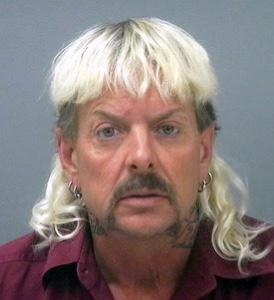
Joe Exotic is the focus of the Netflix documentary series Tiger King. He was a major player in America’s tiger breeding business until he went to prison for his involvement in a murder-for-hire plot. (Photo: Rachel Nuwer)
BASCOMB: So, Rachel, how many big cats are living in the United States right now, roughly?
NUWER: This is crazy. But we actually have no idea how many big cats are living here, you know, in backyards, truck stops, like even in people's like basements. But a few years ago, the Fish and Wildlife Service did estimate that there are more tigers in the US than there remain in the wild. And researchers think there's about 4,000 tigers remaining in the wild around the world. So yeah, there's probably more than 4,000 Tigers here in the country.
BASCOMB: Well, you have a great podcast called Cat People in which you profile a few people, a few big cat owners. Can you tell me about one of them? How did they decide to own a big cat, a tiger, a bobcat and you know what made them want to go down this road to begin with?
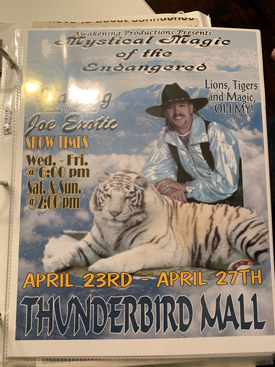
Joe Exotic’s roadside zoo is in Oklahoma, one of four states with no laws restricting big cat ownership. The others are North Carolina, Nevada, and Wisconsin. (Photo: Rachel Nuwer)
NUWER: Sure thing so I kind of think about big cat owners as falling into one of three categories. The first category is people who just really love these animals, like truly they love them. They often are interested in conserving the animals, they want to help the species. I met a woman, for example, named Deborah Pierce. She lives in South Carolina. And she just you know, since she was a little girl, she loved lions. And finally, she talked her husband into getting a baby lion cub. And then shortly after, she also got a baby mountain lion to keep the lion company. And, like, right from the beginning, things just went terribly wrong for Deb. You know, like there was a landslide that took out her cages that she had built for these animals. She realized that she had underestimated how much it costs to feed them. Like as they grew like they eventually ate over $5,000 of meat a year. Veterinary bills just like piled up. You know, we're talking over $10,000 a year on vet bills. Eventually, the stress contributed to Deb's husband leaving her and now she can't travel. She can't move. She can't really do anything. Like she's almost like in a cage of her own making because of these animals. But the thing about Deb is, you know, she was motivated because she loves the animals, she wanted to be near them. And people like her are also motivated by the desire to contribute to their conservation, they think, okay, these animals are endangered. So if I can have one, if I can make more, and keep them safe, I'm helping that the survival of the species.
BASCOMB: I mean, a lion in a cage in South Carolina isn't really serving its ecological purpose. So I mean, what use is it to the species as a whole if these animals are in a cage far away from their natural habitat?
NUWER: It's really not. I mean, it's not useful at all for conservation period. You know, I write a lot about poaching of wildlife in places like Southeast Asia and the exotic pet trade is just a booming market around the world. And once that, like lizard or whatever is snatched from the wild, it's dead ecologically speaking. It's not playing any more role in its habitat. It's not perpetuating the species, and the same goes for all these excess big cats in the US, you know, they're just over here in their little bubble not helping conservation whatsoever.
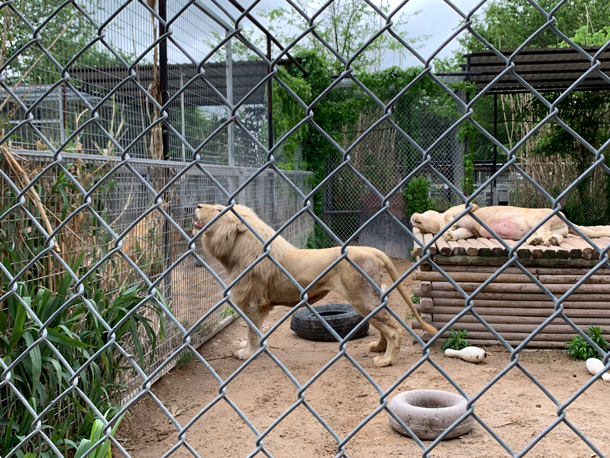
A lion in a roadside zoo. (Photo: Rachel Nuwer)
BASCOMB: Right. Well, that that makes perfect sense. You said there's three categories of people, what are the other two.
NUWER: So the other two are kind of, think of the kind of person who would go out and buy a Ferrari, to show off and to try to be special. It's people who want to stand out from their neighbors who want something to kind of affirm their uniqueness and their coolness and toughness in the world. People will start calling themselves you know, like, I'm the lion woman, or I'm the tiger man. And that's what they become known for. And it's just, it's a way to assert themselves in the world. The last category of people are really the breeders and dealers. These are the Joe Exotics of the world, the people who are in this business, for business, to make money.
BASCOMB: What about animal welfare? I mean, how are these animals usually kept? Are they treated humanely would you say in the whole?
NUWER: Definitely not, unfortunately. This industry is built upon cruelty. So the reason why there are so many pet tigers in the US is not necessarily because there's so many people who are dying to have a tiger. It's because of this cub petting phenomenon. You know, you go to these roadside zoos, you take a selfie with a tiger, you pay like 100 bucks for 10 minutes to cuddle the cub. And then you know, it's the next person's turn. So to produce all these cubs, you know, female tigers are just repeatedly speed bred. As soon as they have a litter of cubs, those cubs are taken away, often within you know, an hour of their birth and bottle fed. The cubs themselves have a terrible life. They often have ringworm, they're malnourished, sometimes they're drugged into submission, you know, so they won't be biting kids that are playing with them, or they're just completely exhausted from being passed around all day long. So there's definitely an element of animal cruelty in the industry.
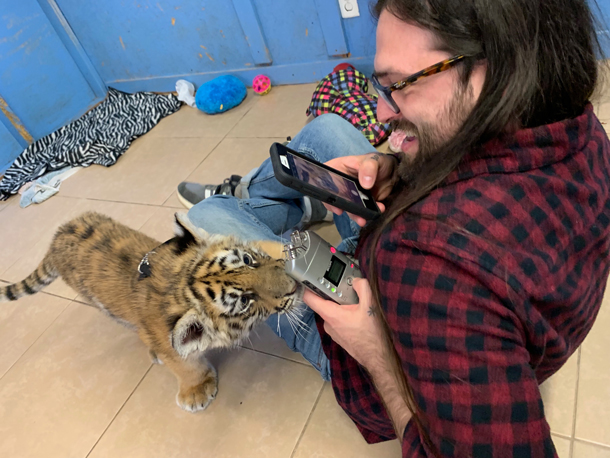
Cub petting experiences offered by roadside zoos incentivize the continued captive breeding of big cats. (Photo: Rachel Nuwer)
BASCOMB: What is the legality of owning these animals here?
NUWER: About two thirds of states have laws banning big cat ownership, then I think about a dozen have laws saying like, okay, well, you can have a big cat, you can have a tiger, whatever, under these certain conditions. And then there are four states that don't have any laws at all. So you can like get whatever you want. It might be harder to get a dog then a tiger.
BASCOMB: Wow, that is that's a crazy notion. And what are those four states? Where can anybody just go get a bobcat? A tiger, a lion, if you feel like it?
NUWER: Those four states are North Carolina, Wisconsin, Nevada and Oklahoma.
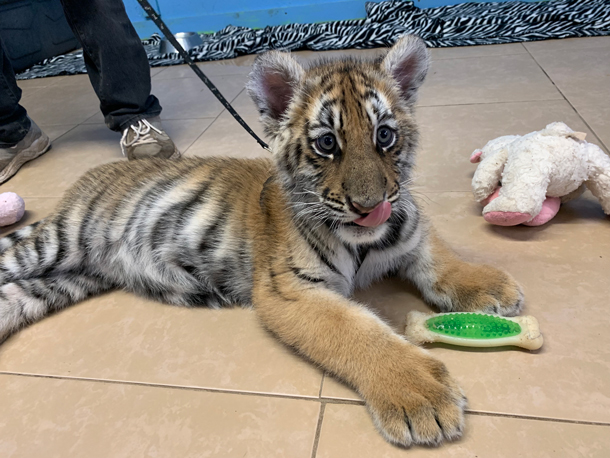
A tiger cub. (Photo: Rachel Nuwer)
BASCOMB: Wow, so really all over the country then?
NUWER: Yeah, exactly. I mean, yeah, it's I don't know why you wouldn't have laws about this. I think people just haven't really thought about it in the past and it's more recently become sort of like a states rights issue and you know, like individual citizens rights issue, like "you can't take away my guns, you can't take away my tigers" kind of thing.
BASCOMB: Now, this is obviously a public safety concern. I want to play a clip from your podcast. This is a 911 call from Ohio.
911 OPERATOR: 911
KOPCHAK: Yeah, this is Ms. Kopchak on Kopchak road, and we live next to Terry Thompson, and there's a bear and a lion out.
911 OPERATOR: There's a bear and a lion out.
KOPCHAK: Yeah, right up behind us.
911 OPERATOR: What's your name?
KOPCHAK: Kopchak
911 OPERATOR: And it's behind your house?
KOPCHAK: Pardon me?
911 OPERATOR: Is it behind your house? Is it behind your house?
KOPCHAK: Yeah, it's up in and they're chasing Terry's horses.
911 OPERATOR: Okay, I'll send them over.
BASCOMB: So what's happening here.

As tigers grow, many big cat owners find that they can no longer properly provide care for their pets. (Photo: Courtesy of Rachel Nuwer)
NUWER: So these are people that, you know, are seeing tigers running down the interstate and are worried and calling in for help. What happened there was this exotic animal owner there named Terry Thompson. And Terry had been arrested for some kind of gun charge. And he actually told the judge, you know, if you put me in jail, the moment I get out, I'm going to release all my animals and blow my brains out. And they're like, haha, whatever, Terry. They put Terry in jail. When Terry got out of jail, he did exactly that. He opened the doors to most of his big cats' cages, and then he committed suicide. And police officers had this situation where they had to then hunt down and kill 18 Tigers, 17 lions, and three mountain lions, plus a bunch of bears, wolves and baboons running around Ohio. So yeah, luckily no humans got hurt in that incident, but very easily someone could have gotten killed. I mean, Terry's place was near a school. It was near hotels. You can imagine.
BASCOMB: Yeah, for sure. That's obviously very, very dangerous.
NUWER: Yeah.
BASCOMB: Well, I mean, we are in the situation now though there's, you know, nobody really knows but thousands certainly of these big cats across the country and relatively unregulated people are getting in over their heads. It seems like a pretty big problem not many people have heard of. But at the end of the day, what should be done about it at this point, do you think?
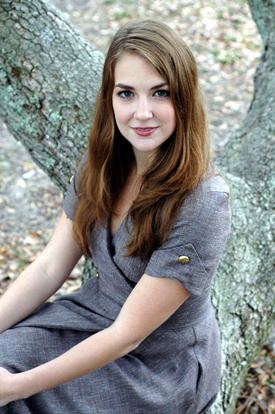
Rachel Nuwer is an investigative journalist and host of the podcast Cat People. (Photo: Courtesy Rachel Nuwer)
NUWER: So? I think what we really need is federal oversight of this issue. You know, we just need a law like it is or it isn't legal to have these things. And luckily, there is a very strong, ongoing effort to get that into law. There's a bill right now, it's in the house and it's awaiting a vote, but it's called the Big Cat Public Safety Act. And what the Big Cat Public Safety Act would do is first of all, it would ban all public contact with big cat species. So that means no more cub petting. So that automatically would cause the industry to dry up because people wouldn't have any incentive to breed these big cats anymore because there would be no more cub petting. And it would also slowly phase out big cat ownership.
BASCOMB: And how likely do you think that is to pass?
NUWER: Surprisingly, I think there's a really good chance because, you know, it's not just like this tree hugger, animal lover issue. For a lot of Republican lawmakers it's a issue of public safety. So there's actually a national sheriff's organization that signed on to it. There's a former police officer who's really been champing it hard, and, you know, when he gets push back from policymakers, he visits in DC who say, you know, like, "Oh, well, I don't want to take away the rights of my constituents." He's like, "Oh, well, so you're not supporting police officers? You don't want to protect police officers?" And that usually gets a reaction. So it's really great. Because the bill does have bipartisan support, and I think it can pass.
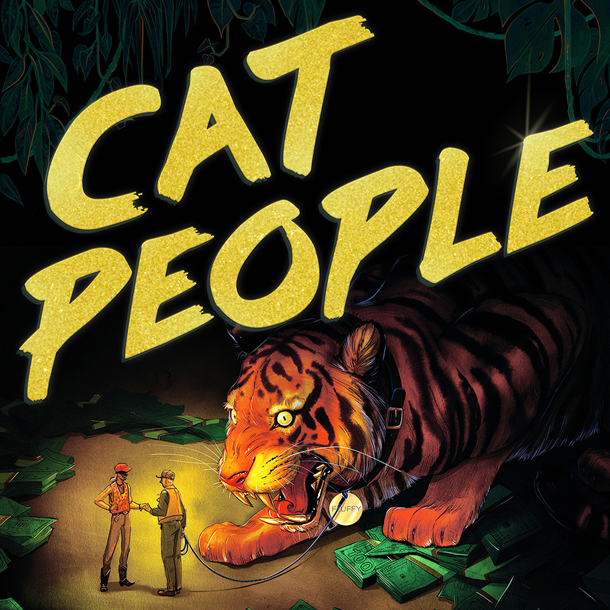
Cat People is a limited series exploring big cat ownership in America. (Illustration Courtesy of Rachel Nuwer)
BASCOMB: Rachel Nuwer is an investigative journalist and host of the podcast, Cat People. Rachel, thank you so much for for sharing these stories with us.
NUWER: Thank you so much for having me and for your interest.
Related links:
- Rachel Nuwer’s Cat People Podcast
- Longreads | “The Strange and Dangerous World of America’s Big Cat People”
- About Rachel Nuwer
[MUSIC: Toots & the Maytals, “Turn It Over” on Just Like That, by F. Hibbert and R. Blade, Mango and Island Records Inc. company]
The Farmer The Grain The Miller The Sea
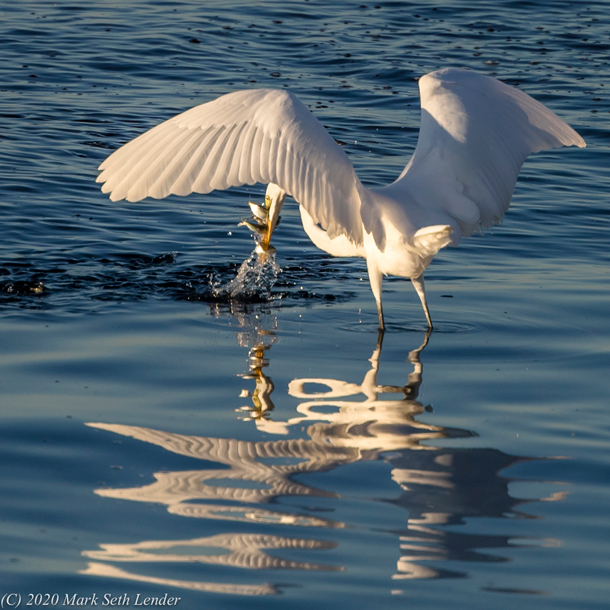
The egret catches a mouthful of menhaden. (Photo: © Mark Seth Lender)
BASCOMB: Well, big cats may draw a crowd but for Living on Earth’s Explorer in Residence, Mark Seth Lender, the real show is much lower down on the food chain.
The Farmer The Grain The Miller The Sea
Menhaden, Striped Bass & Seabirds
Long Island Sound
© 2020 Mark Seth Lender
All Rights Reserved
Menhaden are farming the sea. They plough with their fins shuttling to and fro, and plant among currents known only to them among fields furrowed in waves. And never know if the seed sprouts, or not. And never know the fruit of their labor.
On the tide their plantings drift as if in a calm before storm. Towards shore, then into the rivers: the Neck, the Housatonic, the Thames, the Connecticut and all the tributaries there whose names have been lost to us. The Namers of these freshets and rivulets also long gone.
Everything, changed.
And of the seed? In spite of the wear and erosions of time? Nourished under a cold sun will they find a lighted way?
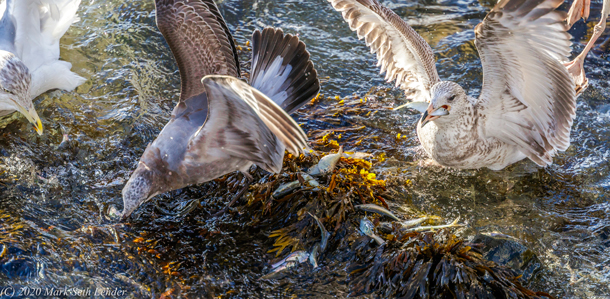
Gulls feast on the little fish. (Photo: (c) Mark Seth Lender)
The months come.
The months go.
The seasons pass…
Autumnal Equinox and the seed heads have ripened to bursting. Young menhaden cloud the shallows with their silvering, thick as grain, churning and turning calling forth though it is against their will, the Harvest:
And from below striped bass, Threshers of the Ocean; and from above the gulls, Reapers of the Air; and along and along paddling and dab-diving double-crested cormorants who are the Gleaners; all come to do their workings. Mouths and teeth and beaks and bills winnowing flesh from water and the little fishes driven in upon the rocky shore to meet in a terrible convergence there tangled in sea weed. As the gulls plunge and scream. The stripers stream, round, and round, and leaping! Double-crested cormorants trim and swimming in a great wedge.
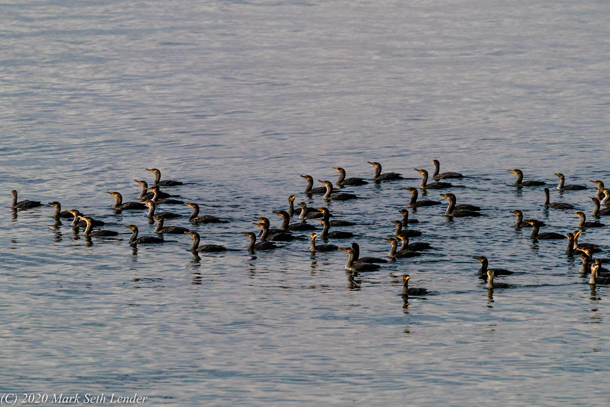
Double-crested cormorants. (Photo: (c) Mark Seth Lender)
V for Victory.
For them!
And for the little fishes?
Now, the Miller comes.
White on white on a field of wet dusky blue, his wings wind-milling, his yellow beak as pallid as the sun. Here, he descends. There, he lands, stilting on a lead of boulders pointing out into the bight. He waits. Patient. Steady. Great Egret all in his elegance! And his long neck plunges to part the surface into a spray, pearls and diamonds of light and water, and lifts five live and struggling, too many to swallow too much to let go he can hardly bear it!.
When -
Rising bursting swimming airborne behind and about Great Egret all for a breathless instant all Brother and Sister Menhaden leap! At once! A turmoil! That cannot be counted!
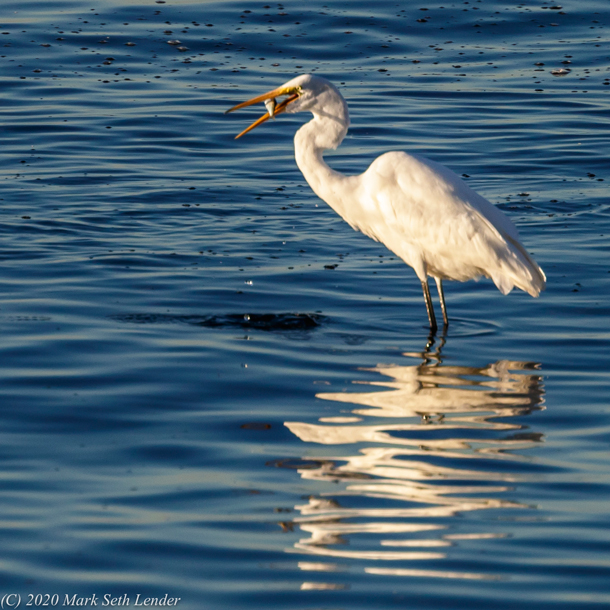
In the end the Great Egret swallows just one menhaden. (Photo: (c) Mark Seth Lender)
Then -
Tumble splunging splashing; while from the Miller’s mouth others fall to greet them; and the wetted stones receive them…
Great Egret in the end swallows just one, overcome, by the richness, of the grain, that grows only in the sea.
BASCOMB: That’s Living on Earth’s Explorer in Residence, Mark Seth Lender.
Related links:
- Read the Field Note for "The Farmer The Grain The Miller The Sea"
- Mark Seth Lender's website
- About Stewart B. McKinney Wildlife Refuge
[MUSIC: John Williams, “Township Kwela” on The Magic Box, by Timothy Walker, Sony Classical]
BASCOMB: Coming up – In the 1800s dogs were used to churn butter and pigs were running in the streets in cities across the United States. That’s just ahead on Living on Earth.
ANNOUNCER: Funding for Living on Earth comes from you, our listeners, and United Technologies, combining a passion for science with engineering to create solutions designed for sustainability in aerospace, building industries, and food refrigeration.
[CUTAWAY MUSIC: John Williams, “Sangara” on The Magic Box, by Francis Beybey, Sony Classical]
Animal City: The Domestication of America

Horses, dogs, pigs and people mingle in a fashionable part of early 19th-century Manhattan. (Image: Carl Fredrik Akrell after Axel Klinckowström, Public Domain)
BASCOMB: It’s Living on Earth, I’m Bobby Bascomb.
For most of modern human history we lived alongside the animals that provided for us. Cows, pigs, sheep and goats freely roamed villages while chickens flapped at our heels. In time, many villages grew into cities and animals were relegated to farms in the country. But throughout the nineteenth century in the United States, livestock still dominated many city streets. Living on Earth’s Jenni Doering spoke with environmental historian Andrew Robichaud, the author of “Animal City: The Domestication of America.”
ROBICHAUD: Anytime really in the early to mid 18 hundred's, you would have encountered a wide range of domesticated animals living in the cities.
DOERING: Picture pigs roaming through the streets of Manhattan, cows grazing on the Boston Common, cattle being slaughtered right in downtown San Francisco.
100,000 horses in New York City.
ROBICHAUD: You would have perhaps seen an urban cattle drive through many of these cities. You might have also seen pigs feeding on trash in city streets, this was a really common problem in many cities, including New York, which has decade after decade of challenges regulating these pigs.
[MUSIC]
DOERING: With all these smelly, messy livestock roaming around, American cities were a bit behind European cities like London.
ROBICHAUD: And in fact, Charles Dickens when he comes in 1842 makes note of these pigs in New York and other cities.
DOERING: Yeah, he calls them gentlemen hogs you write in your book.
ROBICHAUD: He does he, gentlemen, hogs and Republican hogs are are sort of the terminology that gets thrown around around these pigs. And Dickens is fascinated with them. He thinks that this is just so interesting that New York is this major American metropolis, and that there are pigs mixing with these very fashionable people and very fashionable parts of town.
[MUSIC]
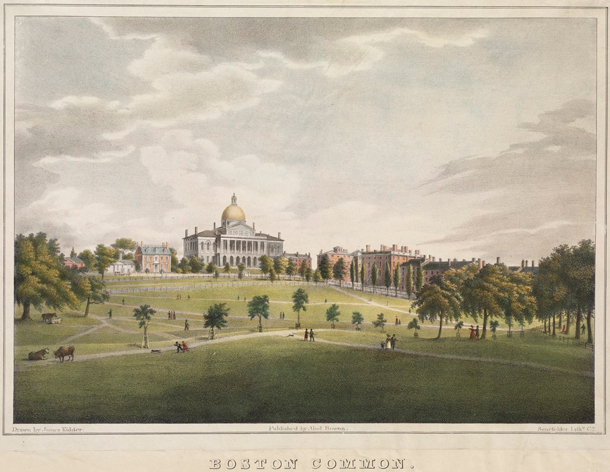
James Kidder’s 1829 lithograph of the Boston Common shows a landscape in transition from a cow pasture and multiuse space into an urban park and place of leisure. (Image: Boston Public Library, CC BY-NC-ND 3.0)
ROBICHAUD: He's seeing these American cities as an interesting urban form.
DOERING: American cities, at the time were rapidly expanding as immigrants arrived from Ireland, Germany, China, and more. And Americans from the countryside were moving to cities to find jobs in the quickly industrializing economy. These new urban residents weren’t coming alone.
[MUSIC]
DOERING: So Andrew, as early Americans started to leave the countryside and they were congregating in these cities like New York like Boston, San Francisco. Why did they bring their animals with them?
ROBICHAUD: Yeah, so I would rephrase that is why wouldn't they, for thousands of years, people lived with livestock. That's how they understood a main component of their subsistence their engagement with the market. It was a really central way of life, to own animals to have animals to eat animals to use animals in all different ways. And it's not completely obvious or inevitable that cities would not be places where people could have those animals. And in fact, what we see in the case of Boston, there are efforts to regulate or restrict the use of the commons for cows for many decades. And there's real pushback from a lot of people in the city to keep the Boston Common as an urban pasture.
[MUSIC]
ROBICHAUD: And so even in these developing industrializing economies and cities, they're still sort of this agrarian ideal that is part of the laws and the landscapes where people can have. If they really want it, they can still have a cow or two if they have the right lot size.
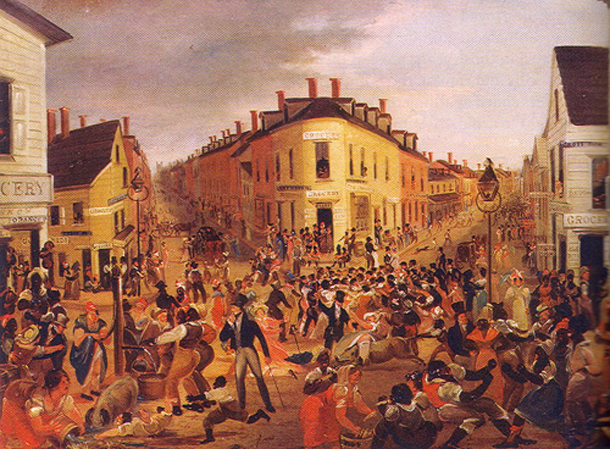
People and animals mix in this 1827 oil painting by George Catlin of the bustling Five Points neighborhood of lower Manhattan. (Image: Wikimedia Commons, Public Domain)
[MUSIC]
DOERING: But it’s only a matter of time before keeping even one or two cows becomes impractical. As people work longer hours in factories they no longer have the time to take care of their own cows.
[MUSIC]
DOERING: And the growing population is demanding huge quantities of milk and meat. And these commodities are produced right in the city.
ROBICHAUD: Sometime in the 1820s 1830s We see the development in New York City of this massive dairy industry, located on the west side somewhere in the 10s and teens of the street grid, where they're these massive oversized barns that are keeping anywhere from 500 to 2000 cows. By one estimate, there are 18,000 cows living in these cramped feedlots in the 1840s. The conditions that the cows were kept in were so abysmal. We tend to think of feedlots as 20th century developments, but we see them in the 19th century.
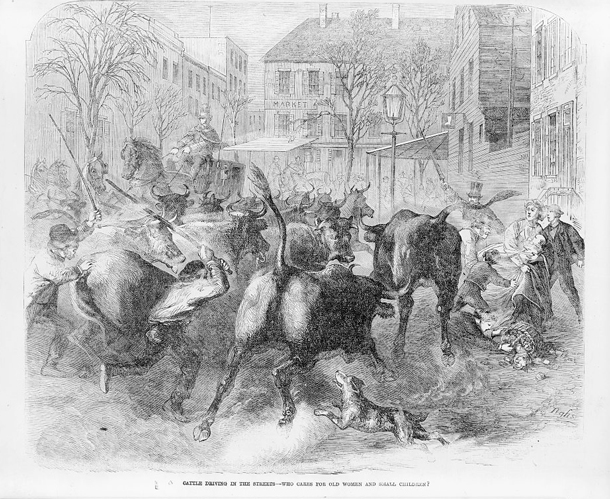
“Cattle Driving in the Streets—Who Cares for Old Women and Small Children?” A depiction of a street scene in New York in 1866, showing the dangers of urban cattle drives that plagued many cities. (Image: Library of Congress)
DOERING: In what is now downtown Manhattan.
ROBICHAUD: In what is now downtown Manhattan, Yeah, yeah. So, yeah, this is the world that's emerging in New York is this really dense urban animal life as well.
[MUSIC]
You know, cows in cities might sound kind of cute and kind of interesting. But what was at stake here was the health of thousands, tens of thousands of urban residents.
DOERING: At the time the child mortality rate was actually increasing. One suspected reason: bad milk. Urban dairies figured out they could cheaply feed their cows leftover swill, or mash, a whiskey by-product.
ROBICHAUD: By the descriptions of reformers they're producing this milk that's watery, it's blueish. Many cases these stables are actually connected to the distilleries And the mash is being piped in to the troughs of these cows piping hot as it's often described.
[MUSIC]

This 19th century illustration of “swill milk” being produced depicts a sickly cow being milked while held up by ropes. (Image: Frank Leslie’s Illustrated Weekly, Public Domain)
DOERING: This stuff was so toxic that the cows would refuse to eat it until they were almost starving, and then it would rot their teeth. The dairies had their ways of adding ingredients to the milk to make it lo ok more natural. They’d add chalk and plaster of Paris, that took care of the weird bluish hue; and other ingredients like molasses, sugar and eggs to mask the taste and smell. Needless to say, these additives made the milk even less healthy. And it was horror over the poor quality of swill milk that inspired the first animal ag reforms in the country, led largely by teetotalers involved in the American Temperance movement. Reformers were also deeply concerned about swill milk as a desecration of divine creation.
ROBICHAUD: The reformers in the 19th century are also thinking about this as a question of nature. And as they see it a question of nature and God's designs. And so they're really paying attention to the anatomy of cows and trying to figure out where do cows belong? And their answer is not in cities, they belong in the country they belong eating grass.
DOERING: Starting in the 1840s, railcars cooled by giant blocks of ice helped enable this for the reformers.
[MUSIC]
ROBICHAUD: And they see the railroad as this really great possibility to bring in country milk and to bring in the health of the country to reform and remake the city, both physically but also culturally and socially.

“Teeth of a Cow fed on natural diet”, above, and “Teeth of a Cow fed on artificial diet”, below, 1842. (Image: Robert Hartley, An Historical, Scientific, and Practical Essay on Milk, Library of Congress)
DOERING: But moving most milk production to the country didn’t actually solve the problems with the quality of milk. Even ice couldn’t protect against bacterial contamination, something that was undiscovered at the time. And, there were no real standards or laws for labeling milk.
ROBICHAUD: What ends up happening is that many of these urban swill Milk Producers start to advertise as country milk, they simply take that trope that's floating around society, they repaint their wagons, they rebrand and they say we're country milk. So it's really hard for consumers to be able to tell where their milk is actually coming from.
DOERING: I mean, we have a similar problem today. It sounds a lot like greenwashing.
ROBICHAUD: Yeah. It's, that's interesting. They, they certainly they didn't have the word for it at that time. But it is, I think it is an interesting example of something that's like greenwashing which is an environmental movement or an environmental reform of some kind that then gets picked up by profit driven interests and sort of twisted around.
[MUSIC]
DOERING: The quality of milk did improve towards the turn of the century as knowledge about bacteria and pasteurization grew, and regulators started requiring tests for adulteration.
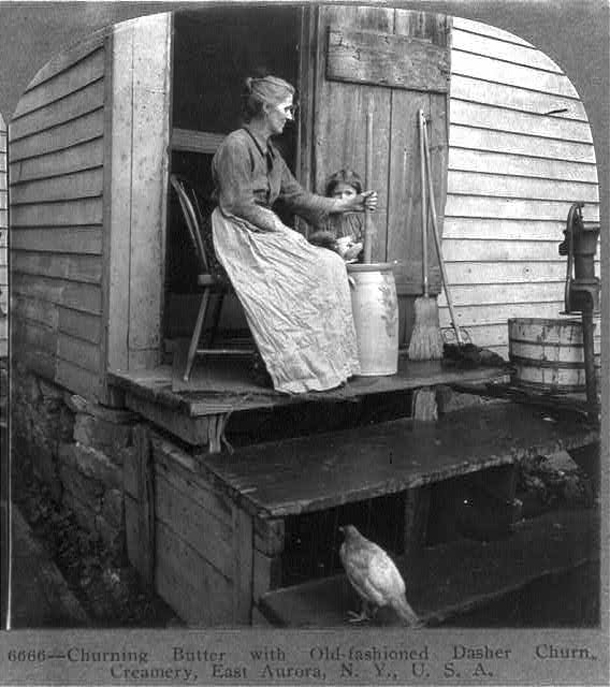
Churning butter was a labor-intensive chore performed mostly by women. (Photo: Library of Congress)
[MUSIC]
DOERING: The working animals in nineteenth century cities also included some animals we might not think of as livestock today.
ROBICHAUD: “Yeah, so this is one of the most surprising things that came out of my research was that dogs are really widely used for labor in American life in the 19th century. “
DOERING: Enterprising inventors figured out how to put man’s best friend to work pressing apples for cider, and churning butter.
ROBICHAUD: “Yeah, so you have to sort of imagine, well, there are all different models of dog machines, but one of the most common ones looks kind of like a treadmill, what they called an endless chain principle machine. And so you have to imagine a dog on a treadmill, moving the treadmill, and that's moving an arm up and down to churn butter. “
“And what's really interesting about this is that it also reflects some deeper changes happening in American life at this time. Churning butter was traditionally work that many women did in an agricultural society in America. And what's happening is that these dairies are growing and producing for markets for urban consumers in many cases in the 19th century in the 1800s. And dogs are doing that work.
[MUSIC]
ROBICHAUD: And so all these agricultural journals are touting the possibilities of dog labor, that dogs will save women from having to do this hard work of churning, which now takes many many hours rather than just a short amount of time.”
DOERING: But some people were concerned about the ethics of using dogs for labor, and in 1874 a high-profile trial in New York City charged the owner of a bulldog put in a cider press machine with animal cruelty.
ROBICHAUD: And it gets at questions of what is a dog is a dog, a creature of labor? is a dog, an animal that we can put to work in different ways?
[MUSIC]
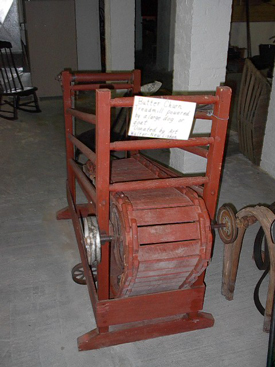
A butter churning dog machine from The Boorman House in Mauston, Wisconsin. (Photo: Sixa369, Wikimedia Commons, CC BY-SA 3.0)
ROBICHAUD: Or are dogs, creatures of leisure, are they pets, and that's really what's at stake here.
DOERING: SPCAs, Societies for the Prevention of Cruelty to Animals, were pushing for dogs as pets, along with better conditions for more traditional livestock like cows, pigs, and horses. George Angell and Henry Bergh founded the first SPCAs in the 1860s, which were largely inspired by a similar movement in Great Britain. These organizations gained considerable power as quasi-governmental animal welfare enforcement agencies, and this type of labor stopped. But their powers only went so far.
ROBICHAUD: And so that dog case that I talked about, where there's a dog who's running this cider press, he's running this machine. The SPCA intervenes, they stopped the owner from doing that. A week later, the owner has put into the treadmill, an eight year old black boy who is now doing the same work that the dog was doing and the SPCA can't do anything and they can't touch it because it's not part of their purview. And so there is this interesting overlap of the development of child protection and animal protection. And in fact, in New York, the SPCC Society for the Prevention of Cruelty to Children is founded after the SPCA and it's founded by most of the same members who realized that they need to create a structure to also be able to prosecute and protect children as they have for animals.
[MUSIC]
DOERING: On America’s other coast, the government is cracking down on slaughterhouses.
ROBICHAUD: Yeah, so this was a big public battle. In the 19th century. They called it the war on butchers in city newspapers and city newspapers covered it quite intensely.
DOERING: We’re at a time in San Francisco’s history when the population is swelling with gold seekers and Chinese immigrants. And the slaughterhouses are being swallowed up by the growing city. The stench of this industry becomes unbearable for locals.
ROBICHAUD: “And what they're doing in San Francisco is they're really saying slaughterhouses and livestock can't operate in large parts of the city and they end up creating a slaughterhouse district in San Francisco. It's called butcher town. But we see this happening in just about every major American city in the 19th century.
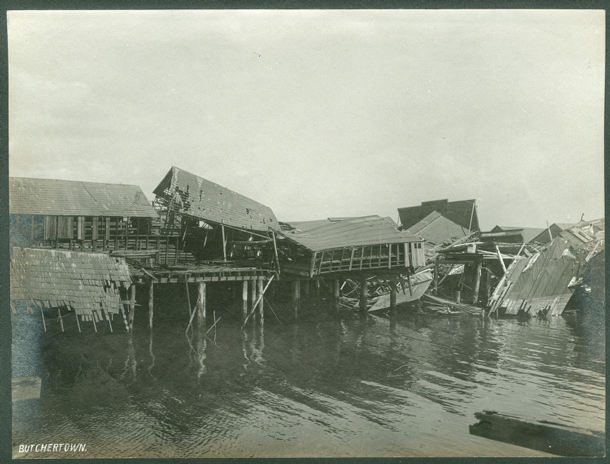
The buildings of San Francisco’s Butchertown, constructed on stilts so that they could release waste straight into tidal waters, fared poorly in the 1906 earthquake. (Photo: DeGolyer Library, Southern Methodist University, Wikimedia Commons)
DOERING: Butcher town became a throwaway place, a part of town where all the noxious animal industries ended up: hog ranches, tanneries, slaughterhouses . . . This district was on the outskirts of San Francisco near the water.
ROBICHAUD: “They're trying to tap into natural features of the landscape, especially water, and saltwater, if you can get it but river water otherwise, as a cleansing agent, they think that the prevailing winds are going to carry all of the miasma as they think of it is really dangerous fumes, unpleasant smells out over the San Francisco Bay, where they'll dissipate, and where they won't cause harm to people.
DOERING: “Yeah, it sounds like a the solution to pollution is dilution kind of mentality, right? Yeah. But I mean, did that cause problems ultimately for the health of the bay?”
ROBICHAUD: “Yeah, so the plans of reformers don't actually work out as they had imagined as, as you might have guessed.
[MUSIC]
ROBICHAUD: Like many environmental problems, there are unintended consequences.
DOERING: More and more slaughterhouses and butcheries are cropping up, and at some point they just overwhelm the system. At the same time, sewage from the growing city and mining waste from far upstream were pouring straight into the same, inky black baywater. And locals were getting pretty fed up.
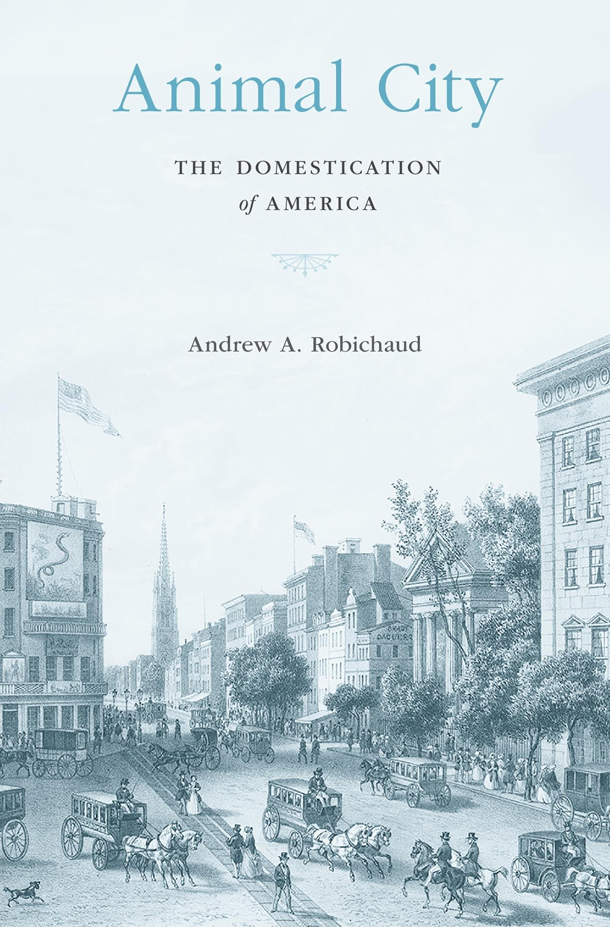
The cover of Animal City: The Domestication of America (Image: Courtesy of Andrew Robichaud)
ROBICHAUD: “ And what's interesting in San Francisco in many other cases is that the government is not going after the polluters. They're going after the people who are using the lands that are polluted. “
DOERING: People like immigrant dairy farmers and Chinese shrimp farmers. The large-scale butcheries and tanneries were basically given a free license to pollute, while small scale producers, who were also dealing with the added cost associated with some of the new regulations were finding it impossible to compete. Polluting fines were the same regardless of the size of the producer. They were a drop in the bucket for large companies, but put many small, family owned producers out of business.
[MUSIC]
ROBICHAUD: I think there really is an environmental justice angle to this project as well, because in 1888, the city passes a law that says that Chinese residents can no longer live downtown they have to live outside of the city and where do they choose to put Chinese residents? Well, they say they have to live in butcher town. In the 20th century is where the city builds a sewage treatment plant. And it's actually a place to where public housing is built largely for African Americans in San Francisco who where being uprooted and removed from downtown. These spaces that are carved out in the 19th century to accommodate these animals suburbs are concentrated animal populations and life and death. They go on to have this long legacy of being redlined in many cases, sometimes they're explicitly redlined. For the smells that they're producing,”
[MUSIC]
DOERING: So by the 20th century, reformers had successfully exiled slaughterhouses and dairies from cities. Urban livestock were almost history, although horses still trotted through city streets until the age of the automobile.
DOERING: So Andrew, kind of looking big picture. How can looking into the history of the animal city help us understand the human animal relationships that we have today?
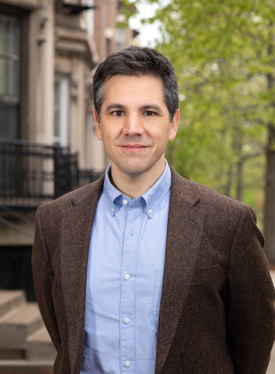
Andrew Robichaud’s next book project is a history of climate, ice, and the ice trade in nineteenth-century North America. (Photo: Courtesy of Andrew Robichaud)
ROBICHAUD: Yeah, well, I think that people living in 19th century cities were really on the forefront of a major change in human history. In many ways, most of us live in the shadow of this world that was created by 19th century reformers who really wanted to create spaces that were clean that were pleasant to be in that were free of brutality and free of blood and free of unpleasant smells.
DOERING: Andrew Robichaud says the brutality is still there, it’s just out of sight, out of mind. And in fact most of our meat and dairy come from CAFOs, Concentrated Animal Feeding Operations, far away from major population centers.
ROBICHAUD: And so this was one of the things that drew me into this project in many ways is that we have this modern landscape of human animal interactions that is so spatial, which is to say we have these really visible and really close relationships with pets with animals that many people treat almost like people. And then we also have this really massive and largely invisible world of feedlots and stockyards and slaughterhouses. This is really a feature of modern life and modern human animal relationships.
[MUSIC]
DOERING: Andrew Robichaud’s next project has a working title of On Ice: Transformations in American Life. It’s a history of climate, ice, and the ice trade in nineteenth century North America.
[MUSIC]
BASCOMB: That’s Living on Earth’s Jenni Doering, speaking with Andrew Robichaud, author of “Animal City: The Domestication of America”.
Related links:
- “Animal City: The Domestication of America” by Andrew Robichaud
- About Andrew Robichaud
- Find Andrew Robichaud on Twitter
[MUSIC: US4, “Heading South” on Stunt Records 2017, by H. Parlan, Sundance – The Scandinavian Music Company]
BASCOMB: Living on Earth is produced by the World Media Foundation. Our crew includes Naomi Arenberg, Paloma Beltran, Thurston Briscoe, Jenni Doering, Jay Feinstein, Merlin Haxhiymeri, Candice Siyun Ji, Don Lyman, Isaac Merson, Aynsley O’Neill, Jake Rego, and Jolanda Omari. We welcome Anne Flaherty this week. Tom Tiger engineered our show. Alison Lirish Dean composed our themes. Special thanks to the Stewart B. McKinney National Wildlife Refuge. You can hear us anytime at L-O-E dot org, Apple Podcasts and Google Podcasts, and like us, please, on our Facebook page - Living on Earth. We tweet from @livingonearth. And find us on Instagram at livingonearthradio. Steve Curwood is our Executive Producer. I’m Bobby Bascomb, Thanks for listening!
ANNOUNCER: Funding for Living on Earth comes from you, our listeners, and from the University of Massachusetts, Boston, in association with its School for the Environment, developing the next generation of environmental leaders. And from the Grantham Foundation for the protection of the environment, supporting strategic communications and collaboration in solving the world’s most pressing environmental problems. Support also comes from the Energy Foundation, serving the public interest by helping to build a strong, clean, energy economy.
ANNOUNCER 2: PRX.
Living on Earth wants to hear from you!
Living on Earth
62 Calef Highway, Suite 212
Lee, NH 03861
Telephone: 617-287-4121
E-mail: comments@loe.org
Newsletter [Click here]
Donate to Living on Earth!
Living on Earth is an independent media program and relies entirely on contributions from listeners and institutions supporting public service. Please donate now to preserve an independent environmental voice.
NewsletterLiving on Earth offers a weekly delivery of the show's rundown to your mailbox. Sign up for our newsletter today!
 Sailors For The Sea: Be the change you want to sea.
Sailors For The Sea: Be the change you want to sea.
 The Grantham Foundation for the Protection of the Environment: Committed to protecting and improving the health of the global environment.
The Grantham Foundation for the Protection of the Environment: Committed to protecting and improving the health of the global environment.
 Contribute to Living on Earth and receive, as our gift to you, an archival print of one of Mark Seth Lender's extraordinary wildlife photographs. Follow the link to see Mark's current collection of photographs.
Contribute to Living on Earth and receive, as our gift to you, an archival print of one of Mark Seth Lender's extraordinary wildlife photographs. Follow the link to see Mark's current collection of photographs.
 Buy a signed copy of Mark Seth Lender's book Smeagull the Seagull & support Living on Earth
Buy a signed copy of Mark Seth Lender's book Smeagull the Seagull & support Living on Earth

